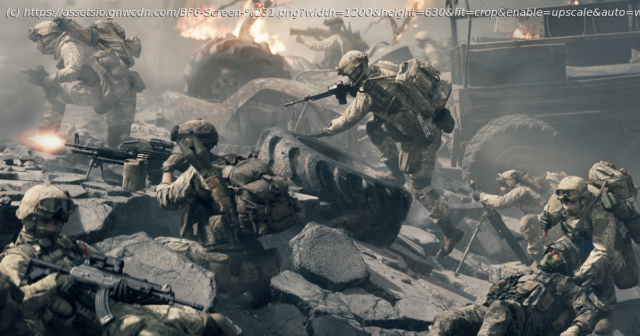Battlefield 6 delivers a thrilling multiplayer reset and decent, if derivative single-player. But shows nagging doubts about what makes Battlefield special.
After the muddled innovations and watered-down warfare of Battlefield 2042, Battlefield 6 was pitched as a return to what made the series great. And it is that…mostly. Gone are the ponderous 128-player maps that stretched 2042’s action too thin, and the pseudo-futuristic setting with gimmicky hero shooter-like abilities. Back are the rollicking 64-player slugfests, the more grounded quartet of soldier classes, the lowercase modern warfare setting, and even the single-player campaign. All this infused with a fetching burned-orange aesthetic and a renewed emphasis on crumbling, billowing destruction.
When it’s firing on all cylinders, jets screaming overhead, rockets whizzing past your ear, building facades sloughing off their foundations before your eyes, Battlefield 6 is tremendous – undoubtedly the closest EA has got to the series’ heyday in a decade. Yet hidden beneath this confident surface is a series still wrestling with its identity. There’s a nervous desire to please everyone in Battlefield 6, visible in its oddly heavy catering to small and midsize maps and modes, the weird compromise between fixed classes and free weapon selection, and the peculiar sight of camo-clad soldiers who can knee-slide into battle and perform a 180 spin at the touch of a button.
In all of this and more, you can feel Call of Duty breathing down Battlefield’s neck. Luckily, this doesn’t detract from the experience too much, and even improves it in some areas. But it’s frustrating nonetheless, because Battlefield 6 is unquestionably at its best when it embraces its identity wholesale.
Battlefield 6’s marginally speculative setting pitches NATO forces against Pax Armata, a politically inoffensive pan-national private military company named like a deluxe wristwatch. Its globetrotting conflict transports players to Cairo, New York, Gibraltar, and Tajikistan, along with a slightly incongruous return to Iran in fan-favourite map Operation Firestorm.
Each location provides multiple themed maps for Battlefield’s centrepiece modes like Conquest, Rush and the newly introduced Escalation – which is basically Conquest with the added ability for teams to claim control points for good. While all wonderful to look at, only three of them use the full spectrum of Battlefield’s arsenal, giving you large expanses of terrain and a sky crisscrossed by both jets and helicopters.
From this trio, I’m primarily partial to Tajikistan’s Mirak Valley, which starts one team in an area that looks like No Man’s Land in World War 1, all scorched earth and blackened trees riven by muddy trenches. Its central area comprises two office buildings in construction, with a giant crane situated between them that players can bring crashing down. While not as map-changing as Battlefield 4’s «Levolution» scenes, it’s quite the sight nonetheless.
Elsewhere, the snowy valley of Liberation Peak isn’t quite as distinctive as Mirak Valley, but it’s still a rock-solid Conquest theatre, its craggy undulations riddled with military bases and deliciously destructible villages. Operation Firestorm, meanwhile, is Operation Firestorm, as fundamentally brilliant as it ever was.
All three maps eagerly facilitate Battlefield’s core appeal – that dynamic, open ended warfare that quite literally drops moments of emergent storytelling on you, usually with concussive force.
Домой
United States
USA — software Battlefield 6 review — the best entry in ages, when it's actually...






